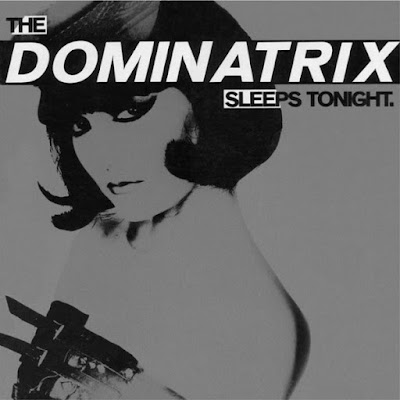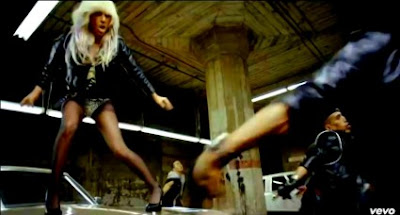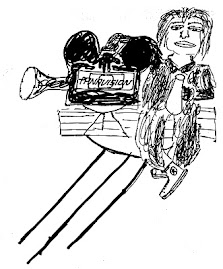A surrealistic, irreverent, and often violent exploration of four college students sharing a seedy house, “The Young Ones,” the first BBC series to debut on MTV, became a cult sensation that has kept its popularity for decades, gave audiences their first look at British comedians later to become worldwide stars, and predicted some of the shows that MTV made famous.
Much as stand-up comedy in America saw a sea change in style and attitude during the ’70s counterculture boom, England in the ‘80s was also in the midst of a shake-up in who would be creating comedy and how it would be done.
Oddly enough, both groups were getting noticed at clubs called The Comedy Store, though England’s had no connection to the famous Mitzi Shore-operated landmark aside from inspiration.
This new breed of British comedians were determined to stand out in direct, punkish contrast to both old traditionalist comedians, white males making cheap and often derogatory jokes about women and minorities, and newer comedians that had more progressive ideas, but were still from affluent backgrounds and thus having a certain detachment from the working class. These were educated but not posh individuals who wanted to shake up the audience, either through confrontational jokes or unconventional behavior.
Among the performers who earned a following from The Comedy Store were Rik Mayall and Adrian Edmondson, who performed unpredictable improv-style sketches under the name 20th Century Coyote, Nigel Planer and Peter Richardson, who did genre lampoons often featuring escalating comic violence as The Outer Limits, and the club’s house M.C., Alexei Sayle, who mixed physical gags with directly left-leaning political material.

Peter Richardson, Jennifer Saunders, Nigel Planer, Arnold Brown, Alexei Sayle, Rik Mayall, Dawn French, Ade Edmondson![]()
These five performers, along with some other promising talents, ultimately decamped and created their own club in Soho, The Comic Strip. Their reputations grew even larger to the point where two TV networks eagerly sought them out to put them on the air.
Channel 4, not yet broadcasting, signed them to a series of six half-hour programs under the umbrella title “The Comic Strip Presents.” As this show was being assembled, the BBC, with producer Paul Jackson, also offered them a series, which would be ostensibly a conventional sitcom, peppered with all the comedians’ strengths, which became “The Young Ones.”
“The Comic Strip Presents” debuted on the night of Channel 4’s first broadcast, November 2, 1982, with “The Young Ones” launching on BBC2 a week later on November 9.
The concept of the show came from Rik Mayall, Lise Mayer — who was dating Mayall during production — and Ben Elton, a college friend later to embark on his own stand-up career. They figured that for a sitcom setting, the actors needed to be in the same room for long stretches of time to play off each other, and while they initially considered making the characters unemployed, thought that notion would be too political.
Instead, Mayall decided to flip the script, and make them college students, saying, “I wanted them to be privileged, and for people to hate them.”
Much of the show’s characters emerged out of existing material the actors had previously worked out on stage. Mayall had created a vain, pompous, and easily angered poet character in his act which evolved into Rick, the posturing political agitator with an incongruous love of Cliff Richard.
Similarly, Planer had been playing a dim, earnest hippie character in his act which became the base for Neil, the glum and easily dominated pacifist. Edmonson had frequently used over-the-top violence in his sketches with Mayall, which was channeled into punk rocker Vyvyan, whose solution to most issues with people and things was to batter them with heavy blunt objects. Sayle effectively served as a human non-sequitur, showing up in an episode, doing something odd, and then leaving the scene.
Mike, the smooth semi-straight man and official “Cool Person” of the house, was the only character that didn’t have an antecedent from the Comic Strip days. It was also the only character not portrayed by a Comic Strip alumnus. While intended for Planer’s partner Peter Richardson, Richardson clashed fiercely with BBC producer Paul Jackson and exited the series before filming, to be replaced by actor Christopher Ryan.
The Young Ones on location in Bristol, UK, August 1982, left to right: Chris Ryan (“Mike”), Rik Mayall (“Rick”), Nigel Planer (“Neil”) and Ade Edmondson (“Vyvyan”)
Together, this character group allowed Mayall and the writers to tweak the template of the traditional family sitcom. “If you look at ‘The Young Ones’, it was a nuclear family. Mike was the dad, Neil was the mum, Vyv was the little boy and Rick was the little girl, complete with pigtails.”
In order to obtain the extra budget they anticipated to include special effects, location shoots, and the other wild items that added to the show’s individuality, the creators decided each episode would feature a musical performance from a band, because this automatically changed the network’s classification of the program from “comedy” to “variety,” and thus allocated them more funds. The bands tended to be left alone to perform their songs, though occasionally they were integrated for humorous effect, as in the episode “Sick”, when Madness prematurely stopped singing “Our House” and fought amongst themselves.
The series quickly became a destination for other comedians, some friends of the show creators, others established elsewhere. Perhaps the most retroactively star-stuffed episode of the series was “Bambi”, which featured appearances by Mel Smith, Griff-Rhys Jones, Robbie Coltrane, Tony Robinson, Stephen Fry, Hugh Laurie, and Emma Thompson.
Since many of these performers had come from more affluent circumstances than the show regulars, the casting was fraught with some class tension, as Alexei Sayle recounted for The Guardian in 2013:
“I turned up for the recording to find several generations of Cambridge Footlights were in the show. ‘I thought these people were the enemy!’ I railed at the writers. ‘The whole point of what we were doing was surely to challenge the smug hegemony of the Oxford, Cambridge, [privileged]-schoolboy comedy network, as well as destroying the old-school working men’s club racists!’ ‘No, that was just you,’ the writers replied. ‘We never subscribed to your demented class-war ravings. We think all these people are lovely…Mel Smith’s going to take us for a ride in his gold Rolls-Royce, and Griff Rhys Jones has been screaming abuse at minions to make us laugh.'”
The series ended for good after its second season in 1984.
Creator Mayall had observed, “If there were only twelve [episodes of] ‘Fawlty Towers’, why would I presume to do more?”
The cast had already moved on to other projects when MTV picked up the U.S. rights to the show and began airing it Sunday nights in June 1985.
Plenty of other British TV comedies had received exposure in America around that time, but most were relegated to selected PBS stations, and, aside from “Monty Python’s Flying Circus,” appealed to an older demographic.
Shows like “Are You Being Served,” and “The Good Life,” with their middle-aged casts and cutesy innuendos and general distance from everyday realities had little appeal to the rock ’n’ roll crowd.
“The Good Life” was directly slagged by Vyvyan in the “Sick” episode as he ranted, “I hate it! It’s so bloody nice! [Those characters are] nothing but a couple of reactionary stereotypes confirming the myth that everyone in Britain is a lovable middle-class eccentric!”
“The Young Ones” quickly became a U.S. hit. John Sykes, then-VP of programming for MTV, told Billboard magazine in November 1985, “Even though there are only fourteen episodes, we find viewers getting more and more excited about the show,” and also suggested the network would commission new episodes.
While that idea did not pan out, MTV later acquired U.S. rights to “The Comic Strip Presents” from Channel 4, and ran those episodes after “The Young Ones” for fans eager to see more of the cast’s work.
Planer’s put-upon hippie Neil became the favorite of U.K. and U.S. viewers alike. A tie-in book, Neil’s Book of the Dead, presenting his musings and poetry, was published in England in 1984.
A companion record followed, Neil’s Heavy Concept Album, featuring prog rock covers and sketches produced by Eurythmics’ Dave Stewart. Its first single, a cover of Traffic’s “Hole in My Shoe,” went to #2 on the UK Singles chart in July 1984.
In late 1985, based on the success of the MTV run, Book of the Dead received a U.S. release, and though the album did not, Planer appeared on MTV as Neil to do a Guest V.J. segment where “Hole in My Shoe” was aired; the video received repeat airings for a short time after.
Though a few years later “The Young Ones” would be gone from MTV, its impact upon the channel was large. Seeing that the music video crowd also craved comedy, MTV would add reruns of shows influential to “The Young Ones”: “Monty Python’s Flying Circus” and “The Monkees.”
Moreover, many of the original shows that MTV launched, as they began their move away from music video programming, can trace their roots to recurrent themes of “The Young Ones.” A house full of diverse individuals with caustic personalities that don’t get along? Here’s “The Real World”! Dim youth watching the telly and making rude observations? Hello “Beavis & Butthead”! Reckless guys subjecting each other to escalating pranks and grievous bodily harm? Welcome to “Jackass”! Self-centered narcissist with bad poetry demanding attention from people who don’t like them? Come to “My Super Sweet Sixteen.”
While allusions to other MTV hit shows may be stretching a point, it’s clear that “The Young Ones” tapped into many primal interests and instincts of a generation, and MTV noticed what those were and exploited them ingeniously.
It’s also notable that afterward, the next British sitcom to take America by storm would be “Absolutely Fabulous,” created by and starring Jennifer Saunders, who was also a member of The Comic Strip collective, a two-time guest star on “The Young Ones,” and since married to star Ade Edmondson. Saunders’ protagonist, Edina Monsoon, got her name by reworking his last name.
Though her husband had only minor impact on the series — singing its theme song, Bob Dylan’s “This Wheel’s On Fire,” and appearing in two episodes — much like his earlier show, “AbFab” also dispensed with the politesse of the stereotypical British comedy and ventured to outrageous, vulgar possibilities that appealed to younger viewers. It too bypassed the traditional PBS route and debuted in the states on MTV’s sister channel Comedy Central.
“AbFab” also featured “Young Ones” alumnus Christopher Ryan in a recurring role as Edina’s first husband, Marshall.
All of the stars of “The Young Ones” continued to create more TV series and other works that fans should definitely seek out. And chances are still very good if you are at a party and happen to reply to someone by saying, “Don’t be all heavy and uncool man,” or snapping, “Well LA-DI-DAH, Neil!” there’s an excellent chance you’ll have a bonding opportunity with a fellow ‘80’s malcontent.
It’s clear that “The Young Ones” mayhem will be enjoyed by young ones for years to come.
(This essay was originally written for Night Flight Plus. It has been recreated in the style it was presented in at the site, and matched to its original date of publication. Tremendous thanks to Stuart Shapiro and Bryan Thomas for the platform.)


































